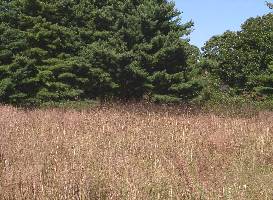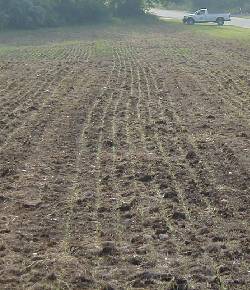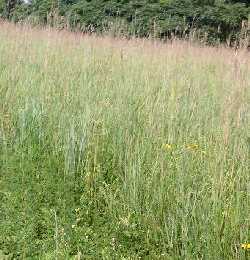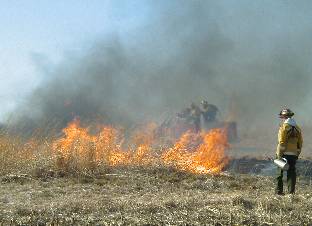| New Jersey Division of Fish and Wildlife |
Wildlife Habitat Incentive
Program (WHIP) Assists State Wildlife Management Areas with Native Grass Restoration
Projects
By Timothy Dunne
NRCS Resource Conservationist
March, 2004
Since spring of 2001 the NJ Division of Fish & Wildlife has worked closely with the US Dept. of Agriculture (USDA) Natural Resources Conservation Service (NRCS) on native grass restoration projects on Division Wildlife Management Areas throughout New Jersey.
|
Dozens of native grass restoration projects have
been implemented since 1998 under NRCS's Wildlife Habitat Incentives Program
(WHIP), mainly on private lands. Under WHIP, NRCS provides financial and technical
assistance to landowners to create, enhance or maintain wildlife habitat on non-Federal
lands in New Jersey. Early successional habitats such as grasslands are a priority
habitat for WHIP in NJ. WHIP sign-up is currently underway until April 2nd, 2004.
Information on participating in WHIP including fact sheets applications and your
local USDA Service Center address can be found at the NRCS - NJ Web site
at www.nj.nrcs.usda.gov/programs/whip.
Beginning in 2001 the Division of Fish and Wildlife signed on to implement native grassland restoration projects on various Wildlife Management Areas, including Beaver Brook and Pequest in Warren County, Greenwood Forest in Ocean County and Buckshutem and Cohansey in Cumberland County. |

|

Native warm-season grasses emerge
about 6 weeks after planting along the Pequest Trout Hatchery and Natural Resource
Education Center entrance road in July, 2002.

A year-old stand of native grasses and forbs in August,
2003, dominated by big bluestem and indiangrass.
|
While these exotic grasses can provide some wildlife habitat, the native grasses that were here when Europeans arrived undoubtedly provide better habitat. The native grasses include "warm season" grasses such as switchgrass, indiangrass, little bluestem, big bluestem, broomsedge and deertounge. These grasses, as the name indicates, grow mostly during the warm summer months of June, July and August. They are mostly clump-forming grasses rather than sod-forming grasses. They grow taller than most European grasses and most stand up very well all winter, even after heavy rain and snow, providing a vertical structural component to winter grassland wildlife habitat. The native plants are adapted to native soil pH and fertility levels and normally no fertilizer or lime is required for establishment. In addition, this vegetation evolved with our climate so the plants are adapted to our frequent periods of drought or water abundance. Some Southeastern US states, that have been seeding thousands of acres of warm season grasses since 1995, report increases of bobwhite quail populations, due in part to the establishment of the native grasslands. Millions of acres of native grasses have been planted in the mid-western US since 1985 under the USDA's Conservation Reserve Program (CRP). Much of the CRP land in the Midwest provides excellent food, cover and nesting habitat for ring-neck pheasants, which in some areas are at all-time high population levels. Positive effects for some grassland songbirds such as grasshopper sparrows, field sparrows, goldfinches and meadowlarks have been reported by universities and wildlife agencies around the country. At Pequest, three small fields, about 1 acre each, were planted to a native grass and forb mixture in May, 2002, near the Natural Resource Education Center. Today, visitors can view showy indiangrass, big and little bluestem, switchgrass, purple coneflower and black-eyed susan along the entrance roadways and trails around the hatchery. Another 15-20 acres of seeding is planned at Pequest. At Beaver Brook WMA, about 12 acres were seeded in more remote areas in 2001 and 2002 to convert active crop fields to native grasses. Although slow to establish, the native grasses are beginning to take hold. The fields should provide food, nesting cover and winter cover for years to come with little maintenance other than occasional mowing or controlled burning to rejuvenate the stands. About 40 acres are planned for seeding at Beaver Brook. |
 NJ Forest Fire Service personnel conduct a prescribed burn of native grasses, established with WHIP financial assistance, at the Pohatcong Grasslands in Warren County. Native grasses thrive under this management and the burned areas will be covered with natives grasses again in 8-10 weeks. |
The
2004 WHIP sign-up deadline is approaching fast. Local NRCS offices will
accept applications until Friday, April 2. Any non-federal land is eligible for
participation in WHIP. Applications are available at any of the six local NRCS
Service Centers throughout NJ. WHIP fact sheets, application forms and NRCS Service
Center contact information can be found on the NRCS Web site at www.nj.nrcs.usda.gov.
Eligible applications will be ranked, and the highest ranking projects will receive WHIP cost-share funds. Land currently enrolled in the Conservation Reserve Program (CRP) or the Wetlands Reserve Program (WRP) is not allowable for WHIP funding. WHIP funds cannot be used where mitigation has been required. Financial assistance will be provided for the initial development of wildlife habitat practices. Landowners must agree to maintain any cost-shared practices and allow NRCS access to monitor the effectiveness of the practices. Cost-share payments of up to 75 percent may be used to establish, maintain, or replace practices.
|